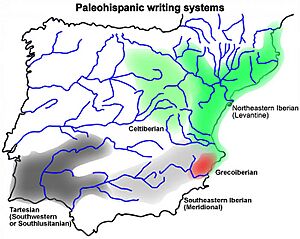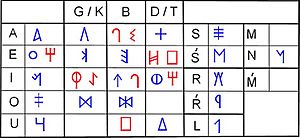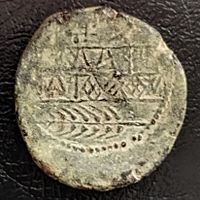Southeastern Iberian script facts for kids
The Southeastern Iberian script, also called Meridional Iberian, was an ancient way of writing the Iberian language. This language was mostly written using the Northeastern Iberian script and sometimes the Greco-Iberian alphabet.
The Southeastern Iberian script and the Northeastern Iberian script are different, even though some of their signs look similar. They have different sound values for the same symbols. However, experts believe they came from the same original writing system. Many think the Northeastern script actually developed from the Southeastern one.
This script is also very similar to the Southwest script, which was used for an unknown language called Tartessian. A big difference is that the Southeastern Iberian script doesn't repeat vowel sounds with its syllable signs.
Scientists are still working to fully understand the Southeastern Iberian script. Many of its signs are not yet completely figured out. Unlike the Northeastern Iberian script, it was thought that the Southeastern script didn't have a way to show the difference between sounds like 'p' and 'b' (called voiced and unvoiced sounds). But some newer studies suggest it might have had a system for this after all.
What Kind of Writing System Is It?
All the ancient paleohispanic scripts (except the Greco-Iberian alphabet) have a special feature. They use signs that stand for whole syllables (like 'ba' or 'ko') for some sounds, and single letters (like 'a' or 'm') for others. This means they are not true alphabets (where each sign is a single letter) or true syllabaries (where each sign is a syllable). Instead, they are a mix, often called semi-syllabaries.
Experts don't fully agree on how these semi-syllabaries started. Some believe they came only from the Phoenician alphabet, while others think the Greek alphabet also played a part.
Where Were These Writings Found?
Writings using the Southeastern Iberian script have been found mostly in the southeastern part of Spain. This includes areas like eastern Andalusia, Murcia, Albacete, Alicante, and Valencia.
These inscriptions were written on many different types of objects. They appear on silver and bronze coins, silver and ceramic pots, lead plaques, and stones. However, there are only about 50 of these inscriptions in total, which is only about 2% of all ancient Iberian writings found.
Some important examples include a lead plaque from Gador (Almeria) and another from La Bastida de les Alcuses (Moixent, València). Most of the time, this script was written from right to left. The oldest writings in Southeastern Iberian script are from the 4th century BCE (about 300s BC), and the newest ones are from the late 2nd century BCE (about 100s BC).

On this coin, the front side has "OBVLCO" written in Latin script. But the back side shows names of local leaders written in Iberian script:
See also
 In Spanish: Escritura ibérica suroriental para niños
In Spanish: Escritura ibérica suroriental para niños
- Greco-Iberian alphabet
- Iberian scripts
- Paleohispanic scripts
- Paleohispanic languages
- Pre-Roman peoples of the Iberian Peninsula





